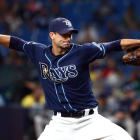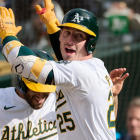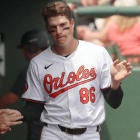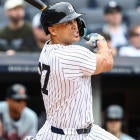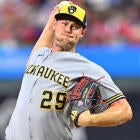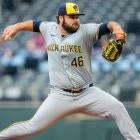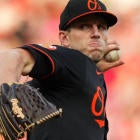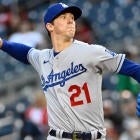When you're drafting your Fantasy team, it ultimately doesn't matter who you draft. You need production — steals and hits and homers and strikeouts — and it doesn't matter where it comes from.
It's important to remember that the names don't matter. You won't win your Fantasy league because you have players who get more votes in All-Star games; you'll win by building the most productive roster. Which is to say, you don't always need to pay up for the brand name.
Often, the generic brand can be as good as the name brand. Okay, I'll grant it probably isn't true for Pop Tarts vs. the pretenders, but in Fantasy baseball, it can be a highly profitable move if you identify the right ones.
For instance, in 2020, players who hit for a ton of power without much in terms of batting average or speed are some of the easiest to find. Pete Alonso is coming off a massive rookie season, and if he repeats that, he'll be well worth his early third-round value, even if power is easy to find. But he's probably not going to repeat his rookie season — there is going to be some regression.
Projections systems will bake in some of that regression, so let's take a look at what SportsLine's ATC projection system expects for Alonso, along with some other players with a similar profile:
Name | ADP | G | HR | R | RBI | AVG |
Pete Alonso | 33.2 | 151 | 43 | 95 | 107 | 0.255 |
56.6 | 150 | 38 | 84 | 100 | 0.256 | |
59.8 | 114 | 33 | 72 | 84 | 0.264 | |
82.6 | 129 | 35 | 79 | 99 | 0.280 | |
91.3 | 146 | 33 | 89 | 93 | 0.261 | |
117.9 | 128 | 35 | 78 | 87 | 0.242 | |
144.9 | 144 | 37 | 76 | 89 | 0.261 |
To be sure, Alonso's expectations are a bit higher, especially in the power and run production categories. The same for Olson, and so it makes sense they are going highest among this group.
But it doesn't really make sense to be the one in your league to reach for them. Sure, Alonso might be a better bet for 40-homers than Reyes or Sano or even Donaldson, but they aren't projected to be far behind him. In this instance, investing a third-rounder in Alonso or a fourth in Olson doesn't make as much sense as waiting for the less pricey players.
That's what we're looking for today: Lower-drafted players to target instead of the big name.
Name Brand: Stephen Strasburg (ADP: 22.0)
Generic: Patrick Corbin (ADP: 36.0) OR Charlie Morton (49.6)
I've made this comp a few times, but it is one of the best examples of what I'm talking about here. When you remove the names all of a sudden Strasburg's apparent edge disappears:
Another one:
— Chris Towers (@CTowersCBS) March 17, 2020
Which player would you rather have for 2020?
Player A (2018-19): 361.2 IP, 3.09 ERA, 1.120 WHIP, 29.7 K%, 8.2 BB%
Player B (18-19): 402 IP, 3.20 ERA, 1.117 WHIP, 29.6 K%, 7.2 BB%
Player C (18-19): 339 IP, 3.48 ERA, 1.100 WHIP, 29.4 K%, 6.8 BB%
Player A is Morton, Player B is Corbin, and Player C is Strasburg. Yep, the most expensive player finished third.
Now, of course, Strasburg was the best of the three in 2019, but it wasn't by a significant margin — wins explain much of the gap, and we know those are unpredictable from year to year. Expect Morton, Corbin, and Strasburg to give you similar production, but only one will cost a second-rounder.
Name Brand: Manny Machado (57.0)
Generic: Mike Moustakas (98.0)
This one feels wrong just looking at those two names next to each other, but that's the point of this exercise. If Machado isn't going to steal many bases anymore, it's probably going to be pretty close. Since leaving the Orioles in mid-2018, Machado is hitting .261 and averaging 79 runs, 30 homers, 86 RBI, and seven steals per-150 games; Moustakas is hitting .253 while averaging 73 runs, 32 homers, 91 RBI, and four steals. Machado has more upside, but we haven't seen any sign of that upside since he stopped calling Camden Yards home — he has one month since July of 2018 with an OPS better than .850. Another red flag? Machado is hitting just .267/.323/.449 away from Camden in his career.
Name Brand: Chris Paddack (52.0)
Generic: Frankie Montas (114.6)
In this one, we're dealing with two pitchers with limited track records of success at the major-league level, so there's risk either way. Paddack threw just 140 innings last season, though that was more than Montas has ever thrown in a professional season — his career high is 136.2 in 2018. However, it's not like Montas missed time last season due to injuries — it was because of a suspension for PED use. If you want to be skeptical he will be able to sustain his breakout, that it was in some way fueled by his PED use, that's fair, though I don't share that skepticism. He introduced a splitter in 2019 that took him to an entirely new level, and no substance can give you a pitch that good.
Paddack has the pedigree, and impressed as a rookie, but Montas was the better pitcher in 2019, sporting a 3.00 FIP compared to Paddack's 3.95 mark. As much as I like Paddack, he probably still needs to refine his curveball to be an ace. If what Montas showed in 2019 was for real, he's already there.
Name Brand: Jonathan Villar (51.0)
Generic: Mallex Smith (174.0)
Okay, in this one, it's not quite the same thing — Villar will hit for more power than Smith. Because Smith won't hit for power. At all.
But VIllar is no lock to hit for substantial power calling Marlins park home. He has hit 35 career home runs in 301 career games at Camden Yards or Miller Park, compared to just 43 in 478 games elsewhere. In 2019 that trend continued, as 16 of his homers came at home, compared to just eight on the road. He might be more like a 10-12 homer hitter in Marlins Park, so you're really just drafting for speed — the homers are a bonus.
And Smith is going to run more. He stole 46 bases last season despite hitting so poorly he was sent back to the minors for a spell. However, he hit .296 the year before and .270 before that, so I would expect something close to a push in average. Call it something close to another push when it comes to runs and RBI, and I'll just wait to get my speed from Smith, thank you.
Name Brand: D.J. LeMahieu (57.4)
Generic: Justin Turner (147.2)
Let's go back to those ATC projections again:
Name | G | PA | HR | R | RBI | SB | AVG |
147 | 643 | 19 | 98 | 76 | 5 | 0.295 | |
Justin Turner | 124 | 525 | 23 | 75 | 71 | 3 | 0.289 |
Again, those projections aren't identical; LeMahieu has a significant edge in runs scored and a small edge in steals and average. However, the counting number gap mostly comes from a difference in projected playing time, and while Turner's history suggests we should expect him to miss some time, LeMahieu is no spring chicken himself, and has missed 51 games the last two seasons himself. If the playing time favors LeMahieu as expected, they'll be pretty close, with LeMahieu likely earning an advantage overall. If the playing time is close to equal, Turner might be better.
Name Brand: Javier Baez (32.8)
Generic: Marcus Semien (84.2)
Here's one where it does require a bit of buying into the one-year breakout, though as Baez showed last season, that isn't necessarily a bad thing. Baez mostly backed up his 2018 breakout with another strong 2019, and if Semien does the same, he's going to be one of the best values in Fantasy in 2020. Baez is a better bet for power, and probably has a bit more upside when it comes to steals, but otherwise, they could be very similar. And, if Semien really does sustain most of last year's breakout, he will probably just be outright better than Baez.
Name Brand: Andrew Benintendi (108.2)
Generic: Adam Eaton (204.4)
Playing time is a bigger question for Eaton, though as he reminded us last season, having missed time in the past does not necessarily mean you will in the future. Eaton played 151 games in 2019, and was a solid Fantasy value as a result. Benintendi has age and perceived upside on his side, though at this point it's getting harder to believe that will matter for Benintendi— he is hitting just .279/.355/.448 since the 2018 All-Star break, still struggles against lefties, and just hasn't seen the power breakthrough we were hoping for. The breakout potential is still here, but in all likelihood, you're going to get very similar production from these two, with Eaton coming at a dramatically cheaper price.
Name Brand: Liam Hendriks (96.4)
Generic: Ken Giles (123.0)
I know what you're thinking: Giles is too inconsistent to trust. And it's true: He has had an ERA north of 4.00 in two of his last four seasons. Not someone you really want to rely on, despite how dominant he was in 2019. That's fair.
Before 2019, Hendriks hadn't had an ERA below 4.13 since 2016, nor a WHIP below 1.25. He was better than Giles in 2019, though that was mostly just due to a 32-inning gap between them; on a per-inning basis, Giles was every bit as good as Hendriks. Maybe Giles will continue to come up short in workload — he did deal with elbow issues last season, after all — but he has a more proven track record than Hendriks, and the Athletics haven't had a pitcher lead them in saves in consecutive seasons since Grant Balfour in 2012-13. Hendriks looked like a dominant closer in 2019 — so did Blake Treinen in 2018.
Name Brand: Jose Berrios (71.2)
Generic: Zack Wheeler (107.8)
I'm intrigued by reports that Berrios was looking to rework his curveball to create more downward movement, and more swings and misses as a result. But the truth is, we haven't seen it yet. What we have seen is a remarkably consistent pitcher on a year-by-year basis, who goes through pretty wild swings in-season. He'll look like an ace one start, and then get batted around the next, but has settled in as a reliable innings-eater with a mid-to-high 3.00s ERA — just like Wheeler has. Wins might be a bit harder to come by for Wheeler, but it shouldn't surprise anyone if he ends up with more than Berrios in 2020 — that's just how wins work. Since returning to full strength from Tommy John surgery, Wheeler has thrown 377.2 innings with a 3.65 ERA and 1.194 WHIP and 8.9 K/9 over the last two seasons; Berrios has a 3.76 ERA and 1.184 WHIP in 392.2 innings in that same span.
Generic: Trevor Bauer (77.4)
Generic: Lance Lynn (126.6)
We can cling to that incredible 2018 as a sign of Bauer's upside, but his track record should tell us there's a pretty slim chance he does that again in any given season. Outside of that one season he's never had an ERA below 4.00 or a WHIP below 1.249.
Lynn enjoyed a career year of his own in 2019, but the track record is actually a lot more impressive overall: An ERA below 4.00 in five of six full seasons, including his dominant 2019. He had never really shown the workhorse ability nor strikeout upside he did in 2019 before, so some skepticism is warranted. But given Bauer's track record, I'm not sure it makes more sense to bet on him regardless of price.
So which sleepers should you snatch in your draft? And which undervalued first baseman can help you win a championship? Visit SportsLine now to get rankings for every single position, all from the model that called Kenta Maeda's huge breakout last season, and find out.














